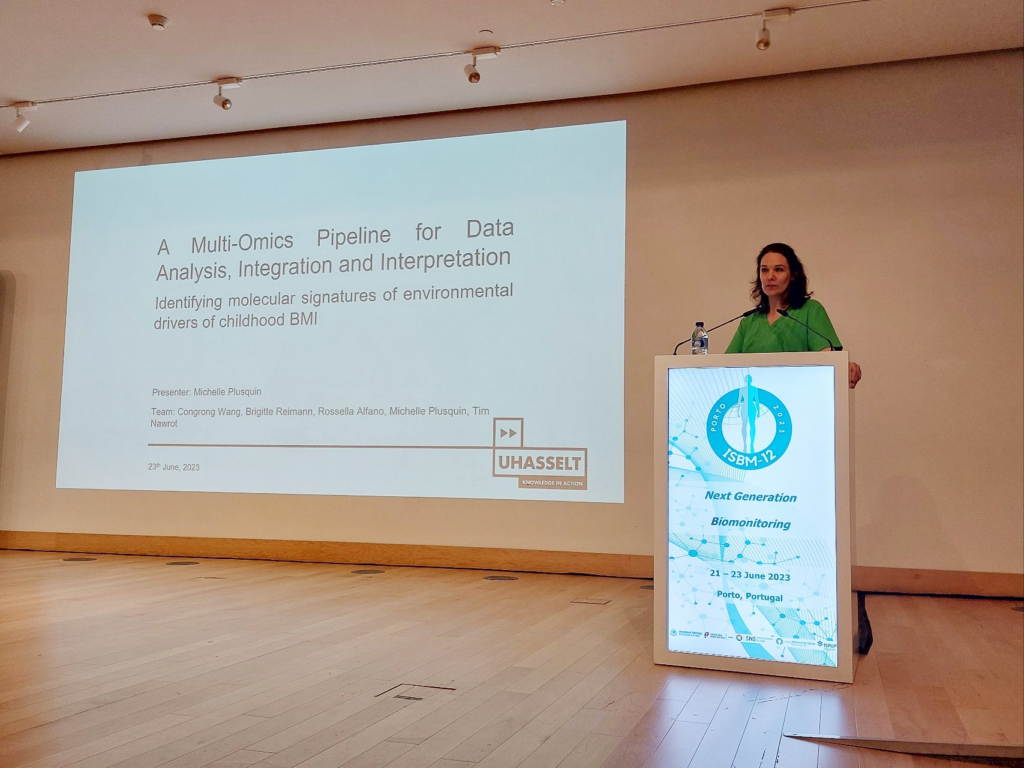Mapping Exposure-Induced Immune Effects: Connecting the Exposome and the Immunome
EXIMIOUS at ISBM-12: From children’s weight growth to hyperspectral imaging
June 29, 2023
Several EXIMIOUS partners presented their latest research at the 12th International Symposium on Biological Monitoring in Occupational and Environmental Health (ISBM-12) held in Porto, Portugal on 21-23 June 2023. The conference featured three EXIMIOUS-related talks by Dr. Carolina Blanch (imec), Prof. Michelle Plusquin (Hasselt University), and EXIMIOUS coordinator Prof. Peter Hoet (KU Leuven). These were held in a special session on multidisciplinary approaches in exposome research, jointly organised by EXIMIOUS and EPHOR, both EU-funded projects part of the larger European Human Exposome Network (EHEN).
The joint EXIMIOUS-EPHOR session on Friday, 23 June, with about 50 attendees, brought together different disciplines and methods to broaden the current perspectives and discussion on exposome research.
Dr. Carolina Blanch’s hyperspectral imaging work was the topic of the first EXIMIOUS presentation in the session. Hyperspectral imaging is a technique that captures a much wider spectrum of light than just the colours that are visible to the human eye. This extracted information can be used to identify and analyse all kinds of materials and objects. In the EXIMIOUS project, hyperspectral imaging is being used as a powerful tool to measure and analyse silica and other types of metal particles that are present in a particular workplace. According to Dr. Blanch, preliminary experiments are showing a high discrimination accuracy of 15 different particle materials at respirable sizes. This means that hyperspectral cameras, especially when used as a portable tool, could help us make a fast initial estimation of the particles present in an environment, which is valuable information when assessing the various exposures faced by people working in the respective environment. “It was an interesting conference overall and a fruitful session,” says Dr. Blanch, looking back on the event. “Exchanges I had with other participants have led to some new ideas about further potential applications of hyperspectral imaging, such as for the contamination assessment of biological tissues.”
It was an interesting conference overall and a fruitful session. Exchanges I had with other participants have led to some new ideas about further potential applications of hyperspectral imaging, such as for the contamination assessment of biological tissues.

Following the hyperspectral imaging presentation, Prof. Michelle Plusquin continued the exposome discussion by looking at weight growth during childhood. In her presented research, various biological factors were explored to understand the complex nature of weight in children, including metabolomics, proteins, and epigenetics. The findings revealed interactions between these different so-called ‘omics’ layers, highlighting the importance of a multi-dimensional approach in unravelling the mechanisms behind weight-related issues.
Finally, our project coordinator, Prof. Peter Hoet, presented a general overview of EHEN and the EXIMIOUS project.
With 5 keynote lectures, 70 posters, and 70 presentations, ISBM-12 was an important event that brought together about 200 of the world’s leading scientists, experts, and students on human biomonitoring.

